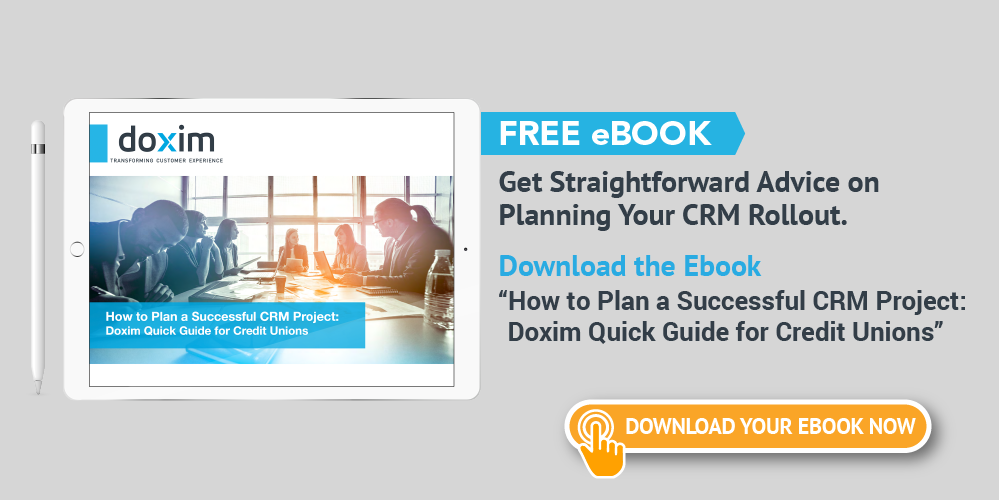Successful CRM implementation starts with strong leadership

As customer interactions become fragmented across more channels than ever before, a CRM system may be your best tool to help provide seamless, insightful customer experience.
To get that all-important single view of the customers, you’ll need a CRM system that serves as a hub for data coming in from all channels, so you can capture all the bits and pieces of information that make up a modern banking relationship, and use them to engage customers, convert more leads, and create life-long loyalty.
Is your current CRM solution up to the task? If not, it may be time to plan for the successful future and build for the growth you seek.
Here are some of the steps you need to take to make sure the process goes smoothly. Remember, enterprise-wide CRM adoption is a cultural shift, so steps involving people are just as important as steps involving tech implementation.
1. Choose the right solution. The CRM marketplace is full of vendors offering “vanilla CRM” solutions, which claim to work for any industry and for any need of the staff. But these often don’t meet the complex needs of credit unions, who contend with complex legacy back office systems, geographically dispersed locations, and the need to keep business processes in compliance with rigorous legislation across all channels.
If you pick a purpose-built solution for financial services from a partner with industry experience, you’ll have access to features and functions designed to meet these unique needs. Plus, you can rely on your vendor to share best practices and real-world experience to make the implementation a success.
2. Select the right champions to lead change. Executive champions bring leadership and vision to your CRM project. But because CRM touches many departments and groups across your credit union, you’ll also need CRM supporters in every branch and location, at every level. And you’ll need to make sure that all champions have a singular vision of how the CRM implementation will benefit your organization.
3. Build and maintain a roadmap. Bring your stakeholders together to create a roadmap for your CRM project. Start by evaluating the gaps between the credit
union’s current state and its desired future state. Then consider how CRM capabilities can help you bridge the gaps. Identify key building blocks, from data migration to process documentation, and assign responsibilities for each.
4. Create a comprehensive messaging plan. You’ll need to communicate how the new CRM solution can help everybody do their jobs better without reorganizing their workflow, and listen to what everybody wants out of it. Be prepared for resistance – old habit die hard, and change makes people nervous, so you’ll need to be proactive about reassuring staff members that the CRM solution will help them meet their KPIs and make their daily lives easier. Make sure you have a mechanism in place for employees to share feedback with your CRM team throughout the planning, implementation, and rollout of the solution.
5. Plan to make training an evergreen activity. Peer-to-peer, role based training is essential if you want your staff to adopt CRM and use it correctly. You also need to recognize that ingraining new habits takes time, allocate resources to offer intensive training up front, then reinforce it later, and make inspection and coaching a perennial task as well. And don’t be afraid to incentivize CRM adoption, or use gamification and scoreboards to encourage CRM uptake at individual branches or locations.
6. Run through your CRM readiness checklist. At this stage in the game, your credit union is ready to go, with a roster of CRM champions in place, training, and communications plans ready to go, and key building blocks and KPIs mapped out. A final systems check can help you identify any last issues before you begin implementation. Your readiness checklist should include questions like these:
- Does everyone have a clear and common understanding of the CRM project?
- Do they understand their specific roles during roll-out?
- Is the feedback process clear for everyone?
- Are cross-functional teams poised to troubleshoot?
- Are all data sources identified? Is there a plan for their integration?
Plan for Success
As the saying goes, “failing to plan is planning to fail”. When a CRM project fails, it is often because the organization hasn’t’ done the groundwork to ensure adoption of the system. If you don’t create and monitor CRM KPIs, you may not even notice when adoption rate and usage drop and the project stagnates.
Conversely, if you take the time to select the right vendor, make a comprehensive implementation plan, build buy-in and rally the organization, you are well on the way to experiencing the enterprise-wide benefits of CRM.
Why is this process so worthwhile? Well, because significant organization-wide benefits of CRM include (but aren’t limited to), a better understanding of members, stronger member relationships, increased loyalty, and the opportunity to leverage member data to market more effectively.
Want more strategies to ensure CRM implementation success? We’ve drawn on over a decade of experience helping credit unions plan CRM projects to offer you some straightforward advice on important steps to follow. Read our eBook to learn more.






